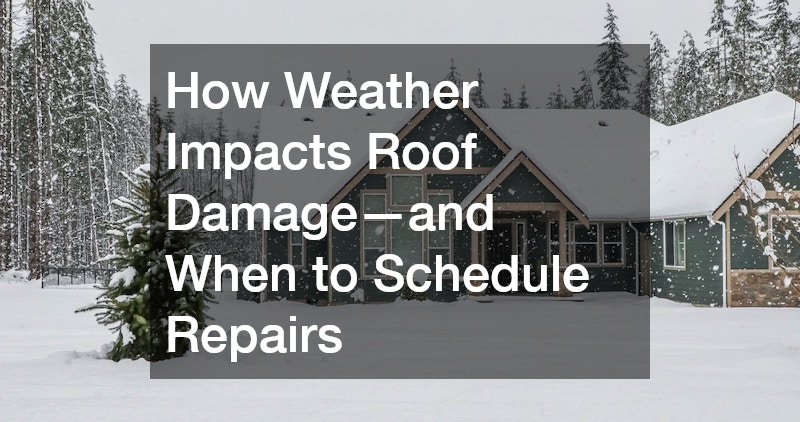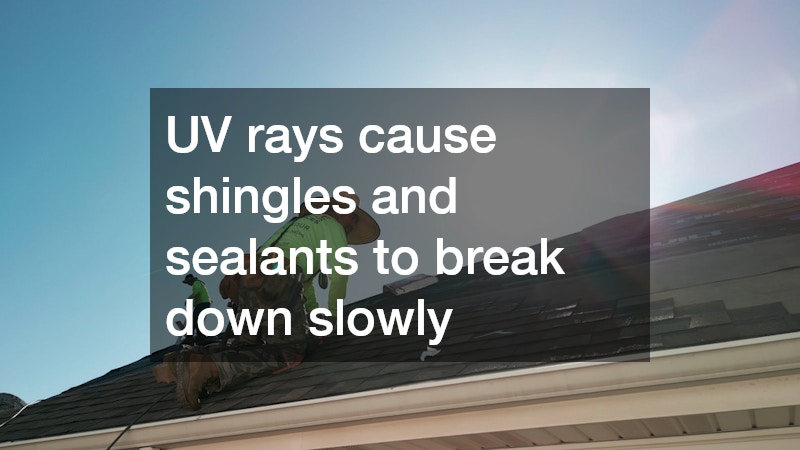Key Takeaways:
-
Weather is the main factor in roof longevity. Heat, rain, snow, wind, and hail all weaken materials differently.
-
Rain and humidity cause leaks and rot. Regular inspections prevent hidden water damage.
-
Sun exposure and heat degrade shingles. UV rays and thermal expansion shorten roof lifespan.
-
Wind and hail require quick professional attention. Even minor impact or lifting can expose the roof deck.
-
Snow and ice add heavy stress. Ice dams and freeze-thaw cycles damage shingles and structure.
-
Seasonal inspections are essential. Spring and fall are the best times to schedule preventive maintenance.
-
Hiring a roofing contractor experienced with repairs ensures accurate diagnosis, cost-effective fixes, and long-term protection.

Your roof stands as the first line of defense between your home and the elements. Rain, snow, hail, wind, and extreme sunlight constantly test the durability of your roofing materials. Over time, even the strongest roof begins to show signs of wear. Knowing how weather impacts roof damage and when to schedule repairs can help homeowners avoid expensive replacements later on.
In this article, we’ll explore how different weather conditions affect roofing systems, the signs of weather-related damage, and when to call the pros for timely intervention.
1. The Relationship Between Weather and Roof Longevity
Weather plays a major role in determining how long your roof lasts. While high-quality installation and regular maintenance extend its lifespan, environmental factors cause gradual deterioration. Materials expand, contract, and erode with changing temperatures and moisture levels.
A professional roofing contractor experienced with repairs can identify how your local climate affects your particular roofing material. For instance:
-
Asphalt shingles in humid climates may develop moss or algae.
-
Clay or tile roofs in hot, dry areas can crack from thermal stress.
-
Metal roofs in coastal zones are more prone to corrosion from salt air.
The goal is not to fight nature, but to anticipate and prepare for how it interacts with your roof over time.
2. Rain: The Most Common Culprit Behind Roof Leaks
Rain is the leading cause of roof deterioration because it exposes weaknesses in shingles, flashing, and underlayment. Even small openings can allow water infiltration, which then spreads through the roof deck and insulation.
How Rain Damages Roofs
-
Persistent leaks: Even a minor leak can allow water to seep into attic insulation and drywall, creating mold or wood rot.
-
Compromised flashing: Flashing around chimneys, vents, and skylights may pull away or corrode, leading to water intrusion.
-
Clogged gutters: When gutters overflow, water can back up beneath shingles and soak the edges of the roof deck.
When to Schedule Repairs
After heavy or consistent rainfall, inspect your attic and ceilings for damp spots or discoloration. If you notice any, contact a roofing contractor experienced with repairs immediately. A professional can pinpoint the leak’s source—often hidden far from where the water appears indoors—and reseal or replace damaged areas before mold develops.
3. Sun and Heat: The Silent Roof Destroyers

Sun exposure is relentless. UV rays cause shingles and sealants to break down slowly, while heat causes roofing materials to expand and contract. Over years, this process weakens the roof’s ability to shed water properly.
How Sunlight Causes Roof Damage
-
Dry, brittle shingles: Asphalt shingles lose flexibility, curl at the edges, and eventually crack.
-
Fading and granule loss: The protective granules on shingles degrade, exposing the asphalt layer beneath.
-
Thermal shock: Repeated heating during the day and cooling at night stresses roof components, particularly in desert or southern regions.
When to Schedule Repairs
Late spring or early fall are ideal times for a professional inspection, since temperatures are moderate. A roofing expert can check for cracked shingles, sealant deterioration, and weakened flashing, addressing these before the summer heat peaks or winter storms set in.
4. Wind: A Force That Exposes Weakness
Strong winds can lift or tear shingles, loosen flashing, and even damage roof decking. The damage may be subtle at first, making professional inspection essential after major wind events.
Wind-Related Roof Damage Includes
-
Lifted shingles: Even partially lifted shingles compromise waterproofing, allowing rain to enter.
-
Edge damage: Wind pressure is strongest at the roof’s edges, where shingles are most vulnerable.
-
Debris impact: Flying branches and objects can puncture or scratch roofing materials.
When to Schedule Repairs
Always inspect your roof after windstorms or hurricanes. If you see loose shingles, debris accumulation, or gaps in flashing, call a roofing contractor experienced with repairs as soon as possible. They can re-secure materials, replace broken components, and inspect for hidden structural damage beneath the surface.
5. Snow and Ice: The Winter Roof’s Worst Enemies
In colder climates, snow and ice create specific challenges that test a roof’s endurance. The weight of snow, freeze-thaw cycles, and ice dams can cause severe, even sudden, damage.
How Winter Conditions Harm Roofs
-
Ice dams: When warm air inside your attic melts snow, the water runs down and refreezes at the edges, creating a barrier that forces water under shingles.
-
Freeze-thaw stress: Trapped moisture freezes and expands, causing shingles to crack or lift.
-
Excess weight: Heavy snow loads can stress structural framing and lead to sagging or leaks.
When to Schedule Repairs
It’s best to schedule a roof inspection in the fall, before snow arrives. A roofing contractor experienced with repairs can ensure proper insulation and ventilation, replace worn flashing, and remove debris that could obstruct water flow. After winter, another inspection can reveal damage hidden beneath snow buildup.
6. Hail: Sudden, Destructive, and Often Overlooked
Hailstorms can cause immediate and significant roof damage. Even small hailstones can bruise or crack shingles, while large hail may puncture or strip away protective layers.
Common Signs of Hail Damage
-
Dented or pitted shingles: Impacts may not cause leaks immediately but weaken waterproofing.
-
Granule loss: Hail knocks off the granules that protect shingles from UV rays.
-
Exposed underlayment: When protective layers wear away, water penetration becomes inevitable.
When to Schedule Repairs
Inspect your roof promptly after any hailstorm. Contact an experienced roofing contractor for a professional assessment, especially if your area experienced widespread hail. They can document the damage for insurance claims and recommend targeted shingle replacement or sealing to prevent leaks.
7. Moisture and Humidity: The Invisible Threats
Even without storms or extreme weather, moisture and humidity can silently undermine a roof’s integrity. Condensation in attics and improper ventilation are two major culprits.
How Humidity Damages Roofs
-
Mold and mildew growth: Excess moisture inside the attic promotes decay.
-
Rust and corrosion: Metal components like flashing and nails deteriorate.
-
Warped decking: Prolonged humidity weakens the wooden roof structure.
When to Schedule Repairs
Have your attic checked during spring or fall. A reliable roofer can test ventilation, inspect insulation, and identify any signs of moisture buildup before it spreads through the roof system.
8. Storms and Seasonal Transitions
Every season presents unique challenges. Spring storms bring heavy rain and wind, summer heat stresses materials, fall debris clogs gutters, and winter introduces ice and weight concerns. Scheduling preventive maintenance around these cycles is crucial.
Recommended Seasonal Inspection Schedule
-
Spring: Check for leaks, flashing damage, and gutter blockages after winter storms.
-
Summer: Look for cracked shingles or sealant damage caused by UV exposure.
-
Fall: Remove debris and confirm your roof is ready for heavy snow or rain.
-
Winter: Watch for ice dams, condensation, or structural stress.
Working with a roofer experienced with repairs ensures that minor issues are caught and fixed before each season’s unique challenges intensify them.
9. How a Professional Contractor Identifies Weather Damage
Weather damage is not always visible to an untrained eye. A skilled roofer uses specialized tools and training to detect weaknesses long before they cause leaks or structural problems.
Professional Inspection Steps Include
-
Exterior Evaluation: Checking shingles, flashing, vents, gutters, and roof valleys.
-
Interior Assessment: Looking for water stains, mold growth, or attic dampness.
-
Moisture Scanning: Using infrared or moisture meters to locate hidden leaks.
-
Structural Review: Examining sagging or uneven roof planes for underlying frame damage.
A professional roofing contractor provides a detailed report and recommends whether a patch, partial replacement, or full restoration is necessary. This approach helps homeowners make informed, cost-effective decisions.
10. Preventive Maintenance to Minimize Weather Damage
Preventive roof maintenance is more affordable than emergency repairs. Regular cleaning, inspections, and minor adjustments protect your investment and extend your roof’s life.
Essential Preventive Steps
-
Clean gutters and downspouts: Prevent water backup and ice dam formation.
-
Trim nearby trees: Reduce the risk of falling branches and debris buildup.
-
Inspect attic insulation: Proper insulation and ventilation reduce moisture accumulation.
-
Check flashing and seals annually: Prevent small gaps that lead to leaks.
-
Schedule professional inspections twice a year: Early detection is key to affordable repairs.
Hiring a trusted roofing contractor for periodic maintenance can uncover subtle damage, maintain warranty compliance, and keep your roof performing optimally year-round.
11. Timing Roof Repairs: Why Scheduling Matters
Knowing when to repair your roof is as important as recognizing the damage itself. Weather conditions affect both the urgency of the problem and the quality of the repair.
Best Times to Schedule Repairs
-
Spring and Fall: These mild seasons provide ideal working temperatures for most roofing materials.
-
Before Severe Weather: Addressing issues before heavy rains or snowstorms prevents emergency situations.
-
Immediately After a Storm: Rapid response minimizes water intrusion and prevents secondary damage.
A roofing contractor experienced with repairs can assess whether conditions are suitable for repair work and advise on temporary fixes if immediate restoration isn’t possible.
12. The Cost of Delaying Weather-Related Repairs
Ignoring minor weather-related roof problems often leads to larger, more expensive issues later. Leaks can spread, insulation can rot, and mold can compromise air quality.
Consequences of Postponing Roof Repairs
-
Increased water damage: Small leaks become major infiltration points.
-
Structural deterioration: Water weakens rafters and decking over time.
-
Higher repair costs: What could be a minor patch job can turn into full roof replacement.
-
Insurance complications: Delayed maintenance can void certain coverage terms.
Working promptly with a roofer experienced with repairs helps avoid these outcomes and ensures that your roof remains structurally sound and energy-efficient.
13. Preparing Your Roof for the Future
Weather patterns are changing, and roofs need to adapt. Investing in modern materials and protective coatings can make your home more resilient.
Future-Proofing Tips
-
Upgrade to impact-resistant shingles: These withstand hail and wind damage better than traditional types.
-
Install proper attic ventilation: Prevents condensation and heat buildup.
-
Consider reflective roofing materials: Reduce UV damage and lower cooling costs.
-
Apply waterproof coatings: Add an extra layer of protection against rain and snow.
An experienced roofing contractor can recommend the best long-term upgrades suited to your local weather patterns.
Conclusion: Stay Ahead of the Weather with Timely Roof Repairs
Weather will always be a challenge for homeowners, but damage doesn’t have to catch you off guard. By understanding how different elements—rain, heat, wind, snow, and hail—affect your roof, you can act before minor wear becomes a major expense.
Scheduling seasonal inspections and working with a roofing contractor experienced with repairs ensures your roof stays strong, efficient, and safe no matter what the climate throws at it. Whether it’s routine maintenance or urgent post-storm repair, timely action protects not just your roof—but your entire home.